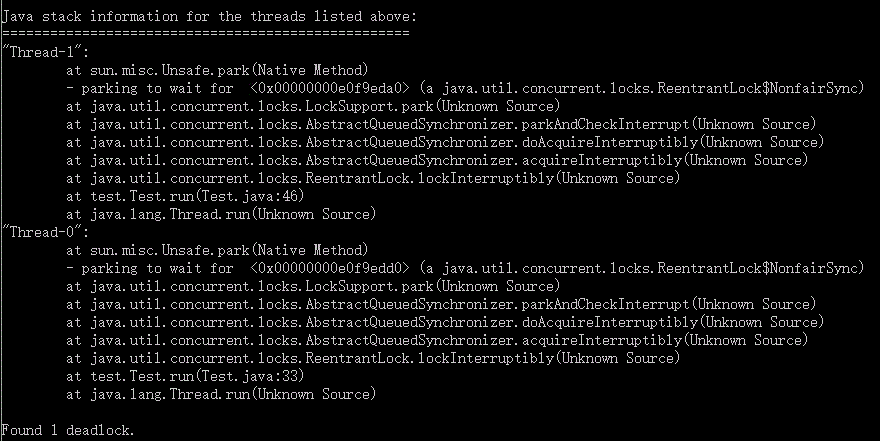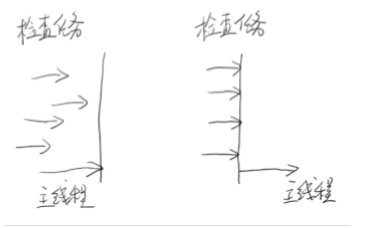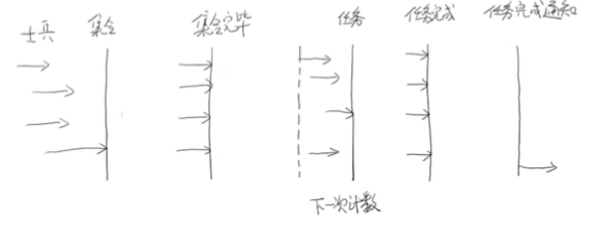标签:shift 处理 倒数 jpg ring oct time seconds extend
ReentrantLock感觉上是synchronized的增强版,synchronized的特点是使用简单,一切交给JVM去处理,但是功能上是比较薄弱的。在JDK1.5之前,ReentrantLock的性能要好于synchronized,由于对JVM进行了优化,现在的JDK版本中,两者性能是不相上下的。如果是简单的实现,不要刻意去使用ReentrantLock。
相比于synchronized,ReentrantLock在功能上更加丰富,它具有可重入、可中断、可限时、公平锁等特点。
首先我们通过一个例子来说明ReentrantLock最初步的用法:
package test;
import java.util.concurrent.locks.ReentrantLock;
public class Test implements Runnable
{
public static ReentrantLock lock = new ReentrantLock();
public static int i = 0;
@Override
public void run()
{
for (int j = 0; j < 10000000; j++)
{
lock.lock();
try
{
i++;
}
finally
{
lock.unlock();
}
}
}
public static void main(String[] args) throws InterruptedException
{
Test test = new Test();
Thread t1 = new Thread(test);
Thread t2 = new Thread(test);
t1.start();
t2.start();
t1.join();
t2.join();
System.out.println(i);
}
}有两个线程都对i进行++操作,为了保证线程安全,使用了 ReentrantLock,从用法上可以看出,与 synchronized相比,ReentrantLock就稍微复杂一点。因为必须在finally中进行解锁操作,如果不在 finally解锁,有可能代码出现异常锁没被释放,而synchronized是由JVM来释放锁。
那么ReentrantLock到底有哪些优秀的特点呢?
单线程可以重复进入,但要重复退出
lock.lock();
lock.lock();
try
{
i++;
}
finally
{
lock.unlock();
lock.unlock();
}由于ReentrantLock是重入锁,所以可以反复得到相同的一把锁,它有一个与锁相关的获取计数器,如果拥有锁的某个线程再次得到锁,那么获取计数器就加1,然后锁需要被释放两次才能获得真正释放(重入锁)。这模仿了 synchronized 的语义;如果线程进入由线程已经拥有的监控器保护的 synchronized 块,就允许线程继续进行,当线程退出第二个(或者后续) synchronized 块的时候,不释放锁,只有线程退出它进入的监控器保护的第一个synchronized 块时,才释放锁。
public class Child extends Father implements Runnable{
final static Child child = new Child();//为了保证锁唯一
public static void main(String[] args) {
for (int i = 0; i < 50; i++) {
new Thread(child).start();
}
}
public synchronized void doSomething() {
System.out.println("1child.doSomething()");
doAnotherThing(); // 调用自己类中其他的synchronized方法
}
private synchronized void doAnotherThing() {
super.doSomething(); // 调用父类的synchronized方法
System.out.println("3child.doAnotherThing()");
}
@Override
public void run() {
child.doSomething();
}
}
class Father {
public synchronized void doSomething() {
System.out.println("2father.doSomething()");
}
}我们可以看到一个线程进入不同的 synchronized方法,是不会释放之前得到的锁的。所以输出还是顺序输出。所以synchronized也是重入锁
输出:
1child.doSomething()
2father.doSomething()
3child.doAnotherThing()
1child.doSomething()
2father.doSomething()
3child.doAnotherThing()
1child.doSomething()
2father.doSomething()
3child.doAnotherThing()
...与synchronized不同的是,ReentrantLock对中断是有响应的。中断相关知识查看[高并发Java 二] 多线程基础
普通的lock.lock()是不能响应中断的,lock.lockInterruptibly()能够响应中断。
我们模拟出一个死锁现场,然后用中断来处理死锁
package test;
import java.lang.management.ManagementFactory;
import java.lang.management.ThreadInfo;
import java.lang.management.ThreadMXBean;
import java.util.concurrent.locks.ReentrantLock;
public class Test implements Runnable
{
public static ReentrantLock lock1 = new ReentrantLock();
public static ReentrantLock lock2 = new ReentrantLock();
int lock;
public Test(int lock)
{
this.lock = lock;
}
@Override
public void run()
{
try
{
if (lock == 1)
{
lock1.lockInterruptibly();
try
{
Thread.sleep(500);
}
catch (Exception e)
{
// TODO: handle exception
}
lock2.lockInterruptibly();
}
else
{
lock2.lockInterruptibly();
try
{
Thread.sleep(500);
}
catch (Exception e)
{
// TODO: handle exception
}
lock1.lockInterruptibly();
}
}
catch (Exception e)
{
// TODO: handle exception
}
finally
{
if (lock1.isHeldByCurrentThread())
{
lock1.unlock();
}
if (lock2.isHeldByCurrentThread())
{
lock2.unlock();
}
System.out.println(Thread.currentThread().getId() + ":线程退出");
}
}
public static void main(String[] args) throws InterruptedException
{
Test t1 = new Test(1);
Test t2 = new Test(2);
Thread thread1 = new Thread(t1);
Thread thread2 = new Thread(t2);
thread1.start();
thread2.start();
Thread.sleep(1000);
//DeadlockChecker.check();
}
static class DeadlockChecker
{
private final static ThreadMXBean mbean = ManagementFactory
.getThreadMXBean();
final static Runnable deadlockChecker = new Runnable()
{
@Override
public void run()
{
// TODO Auto-generated method stub
while (true)
{
long[] deadlockedThreadIds = mbean.findDeadlockedThreads();
if (deadlockedThreadIds != null)
{
ThreadInfo[] threadInfos = mbean.getThreadInfo(deadlockedThreadIds);
for (Thread t : Thread.getAllStackTraces().keySet())
{
for (int i = 0; i < threadInfos.length; i++)
{
if(t.getId() == threadInfos[i].getThreadId())
{
t.interrupt();
}
}
}
}
try
{
Thread.sleep(5000);
}
catch (Exception e)
{
// TODO: handle exception
}
}
}
};
public static void check()
{
Thread t = new Thread(deadlockChecker);
t.setDaemon(true);
t.start();
}
}
}上述代码有可能会发生死锁,线程1得到lock1,线程2得到lock2,然后彼此又想获得对方的锁。
我们用jstack查看运行上述代码后的情况

的确发现了一个死锁。
DeadlockChecker.check();方法用来检测死锁,然后把死锁的线程中断。中断后,线程正常退出。
超时不能获得锁,就返回false,不会永久等待构成死锁
使用lock.tryLock(long timeout, TimeUnit unit)来实现可限时锁,参数为时间和单位。
举个例子来说明下可限时:
package test;
import java.util.concurrent.TimeUnit;
import java.util.concurrent.locks.ReentrantLock;
public class Test implements Runnable
{
public static ReentrantLock lock = new ReentrantLock();
@Override
public void run()
{
try
{
if (lock.tryLock(5, TimeUnit.SECONDS))
{
Thread.sleep(6000);
}
else
{
System.out.println("get lock failed");
}
}
catch (Exception e)
{
}
finally
{
if (lock.isHeldByCurrentThread())
{
lock.unlock();
}
}
}
public static void main(String[] args)
{
Test t = new Test();
Thread t1 = new Thread(t);
Thread t2 = new Thread(t);
t1.start();
t2.start();
}
}使用两个线程来争夺一把锁,当某个线程获得锁后,sleep6秒,每个线程都只尝试5秒去获得锁。
所以必定有一个线程无法获得锁。无法获得后就直接退出了。
输出:
get lock failed使用方式:
public ReentrantLock(boolean fair)
public static ReentrantLock fairLock = new ReentrantLock(true);一般意义上的锁是不公平的,不一定先来的线程能先得到锁,后来的线程就后得到锁。不公平的锁可能会产生饥饿现象。
公平锁的意思就是,这个锁能保证线程是先来的先得到锁。虽然公平锁不会产生饥饿现象,但是公平锁的性能会比非公平锁差很多。
Condition与ReentrantLock的关系就类似于synchronized与Object.wait()/signal()
await()方法会使当前线程等待,同时释放当前锁,当其他线程中使用signal()时或者signalAll()方法时,线 程会重新获得锁并继续执行。或者当线程被中断时,也能跳出等待。这和Object.wait()方法很相似。
awaitUninterruptibly()方法与await()方法基本相同,但是它并不会再等待过程中响应中断。 singal()方法用于唤醒一个在等待中的线程。相对的singalAll()方法会唤醒所有在等待中的线程。这和Obejct.notify()方法很类似。
这里就不再详细介绍了。举个例子来说明:
package test;
import java.util.concurrent.locks.Condition;
import java.util.concurrent.locks.ReentrantLock;
public class Test implements Runnable
{
public static ReentrantLock lock = new ReentrantLock();
public static Condition condition = lock.newCondition();
@Override
public void run()
{
try
{
lock.lock();
condition.await();
System.out.println("Thread is going on");
}
catch (Exception e)
{
e.printStackTrace();
}
finally
{
lock.unlock();
}
}
public static void main(String[] args) throws InterruptedException
{
Test t = new Test();
Thread thread = new Thread(t);
thread.start();
Thread.sleep(2000);
lock.lock();
condition.signal();
lock.unlock();
}
}上述例子很简单,让一个线程await住,让主线程去唤醒它。condition.await()/signal只能在得到锁以后使用。
对于锁来说,它是互斥的排他的。意思就是,只要我获得了锁,没人能再获得了。
而对于Semaphore来说,它允许多个线程同时进入临界区。可以认为它是一个共享锁,但是共享的额度是有限制的,额度用完了,其他没有拿到额度的线程还是要阻塞在临界区外。当额度为1时,就相等于lock
下面举个例子:
package test;
import java.util.concurrent.ExecutorService;
import java.util.concurrent.Executors;
import java.util.concurrent.Semaphore;
public class Test implements Runnable
{
final Semaphore semaphore = new Semaphore(5);
@Override
public void run()
{
try
{
semaphore.acquire();
Thread.sleep(2000);
System.out.println(Thread.currentThread().getId() + " done");
}
catch (Exception e)
{
e.printStackTrace();
}finally {
semaphore.release();
}
}
public static void main(String[] args) throws InterruptedException
{
ExecutorService executorService = Executors.newFixedThreadPool(20);
final Test t = new Test();
for (int i = 0; i < 20; i++)
{
executorService.submit(t);
}
}
}有一个20个线程的线程池,每个线程都去 Semaphore的许可,Semaphore的许可只有5个,运行后可以看到,5个一批,一批一批地输出。
当然一个线程也可以一次申请多个许可
public void acquire(int permits) throws InterruptedExceptionReadWriteLock是区分功能的锁。读和写是两种不同的功能,读-读不互斥,读-写互斥,写-写互斥。
这样的设计是并发量提高了,又保证了数据安全。
使用方式:
private static ReentrantReadWriteLock readWriteLock=new ReentrantReadWriteLock();
private static Lock readLock = readWriteLock.readLock();
private static Lock writeLock = readWriteLock.writeLock();详细例子可以查看 Java实现生产者消费者问题与读者写者问题,这里就不展开了。
倒数计时器
一种典型的场景就是火箭发射。在火箭发射前,为了保证万无一失,往往还要进行各项设备、仪器的检查。 只有等所有检查完毕后,引擎才能点火。这种场景就非常适合使用CountDownLatch。它可以使得点火线程
,等待所有检查线程全部完工后,再执行
使用方式:
static final CountDownLatch end = new CountDownLatch(10);
end.countDown();
end.await();示意图:

一个简单的例子:
package test;
import java.util.concurrent.CountDownLatch;
import java.util.concurrent.ExecutorService;
import java.util.concurrent.Executors;
public class Test implements Runnable
{
static final CountDownLatch countDownLatch = new CountDownLatch(10);
static final Test t = new Test();
@Override
public void run()
{
try
{
Thread.sleep(2000);
System.out.println("complete");
countDownLatch.countDown();
}
catch (Exception e)
{
e.printStackTrace();
}
}
public static void main(String[] args) throws InterruptedException
{
ExecutorService executorService = Executors.newFixedThreadPool(10);
for (int i = 0; i < 10; i++)
{
executorService.execute(t);
}
countDownLatch.await();
System.out.println("end");
executorService.shutdown();
}
}主线程必须等待10个线程全部执行完才会输出"end"。
和CountDownLatch相似,也是等待某些线程都做完以后再执行。与CountDownLatch区别在于这个计数器可以反复使用。比如,假设我们将计数器设置为10。那么凑齐第一批1 0个线程后,计数器就会归零,然后接着凑齐下一批10个线程
使用方式:
public CyclicBarrier(int parties, Runnable barrierAction)
barrierAction就是当计数器一次计数完成后,系统会执行的动作
await()示意图:

下面举个例子:
package test;
import java.util.concurrent.CyclicBarrier;
public class Test implements Runnable
{
private String soldier;
private final CyclicBarrier cyclic;
public Test(String soldier, CyclicBarrier cyclic)
{
this.soldier = soldier;
this.cyclic = cyclic;
}
@Override
public void run()
{
try
{
//等待所有士兵到齐
cyclic.await();
dowork();
//等待所有士兵完成工作
cyclic.await();
}
catch (Exception e)
{
// TODO Auto-generated catch block
e.printStackTrace();
}
}
private void dowork()
{
// TODO Auto-generated method stub
try
{
Thread.sleep(3000);
}
catch (Exception e)
{
// TODO: handle exception
}
System.out.println(soldier + ": done");
}
public static class BarrierRun implements Runnable
{
boolean flag;
int n;
public BarrierRun(boolean flag, int n)
{
super();
this.flag = flag;
this.n = n;
}
@Override
public void run()
{
if (flag)
{
System.out.println(n + "个任务完成");
}
else
{
System.out.println(n + "个集合完成");
flag = true;
}
}
}
public static void main(String[] args)
{
final int n = 10;
Thread[] threads = new Thread[n];
boolean flag = false;
CyclicBarrier barrier = new CyclicBarrier(n, new BarrierRun(flag, n));
System.out.println("集合");
for (int i = 0; i < n; i++)
{
System.out.println(i + "报道");
threads[i] = new Thread(new Test("士兵" + i, barrier));
threads[i].start();
}
}
}打印结果:
集合
0报道
1报道
2报道
3报道
4报道
5报道
6报道
7报道
8报道
9报道
10个集合完成
士兵5: done
士兵7: done
士兵8: done
士兵3: done
士兵4: done
士兵1: done
士兵6: done
士兵2: done
士兵0: done
士兵9: done
10个任务完成提供线程阻塞原语
和suspend类似
LockSupport.park();
LockSupport.unpark(t1);与suspend相比 不容易引起线程冻结
LockSupport的思想呢,和 Semaphore有点相似,内部有一个许可,park的时候拿掉这个许可,unpark的时候申请这个许可。所以如果unpark在park之前,是不会发生线程冻结的。
下面的代码是[高并发Java 二] 多线程基础中suspend示例代码,在使用suspend时会发生死锁。
package test;
import java.util.concurrent.locks.LockSupport;
public class Test
{
static Object u = new Object();
static TestSuspendThread t1 = new TestSuspendThread("t1");
static TestSuspendThread t2 = new TestSuspendThread("t2");
public static class TestSuspendThread extends Thread
{
public TestSuspendThread(String name)
{
setName(name);
}
@Override
public void run()
{
synchronized (u)
{
System.out.println("in " + getName());
//Thread.currentThread().suspend();
LockSupport.park();
}
}
}
public static void main(String[] args) throws InterruptedException
{
t1.start();
Thread.sleep(100);
t2.start();
// t1.resume();
// t2.resume();
LockSupport.unpark(t1);
LockSupport.unpark(t2);
t1.join();
t2.join();
}
}而使用 LockSupport则不会发生死锁。
另外
park()能够响应中断,但不抛出异常。中断响应的结果是,park()函数的返回,可以从Thread.interrupted()得到中断标志。
在JDK当中有大量地方使用到了park,当然LockSupport的实现也是使用unsafe.park()来实现的。
public static void park() {
unsafe.park(false, 0L);
}下面来介绍下ReentrantLock的实现,ReentrantLock的实现主要由3部分组成:
ReentrantLock的父类中会有一个state变量来表示同步的状态
/**
* The synchronization state.
*/
private volatile int state;通过CAS操作来设置state来获取锁,如果设置成了1,则将锁的持有者给当前线程
final void lock() {
if (compareAndSetState(0, 1))
setExclusiveOwnerThread(Thread.currentThread());
else
acquire(1);
}如果拿锁不成功,则会做一个申请
public final void acquire(int arg) {
if (!tryAcquire(arg) &&
acquireQueued(addWaiter(Node.EXCLUSIVE), arg))
selfInterrupt();
}首先,再去申请下试试看tryAcquire,因为此时可能另一个线程已经释放了锁。
如果还是没有申请到锁,就addWaiter,意思是把自己加到等待队列中去
private Node addWaiter(Node mode) {
Node node = new Node(Thread.currentThread(), mode);
// Try the fast path of enq; backup to full enq on failure
Node pred = tail;
if (pred != null) {
node.prev = pred;
if (compareAndSetTail(pred, node)) {
pred.next = node;
return node;
}
}
enq(node);
return node;
}其间还会有多次尝试去申请锁,如果还是申请不到,就会被挂起
private final boolean parkAndCheckInterrupt() {
LockSupport.park(this);
return Thread.interrupted();
}同理,如果在unlock操作中,就是释放了锁,然后unpark,这里就不具体讲了。
我们知道HashMap不是一个线程安全的容器,最简单的方式使HashMap变成线程安全就是使用Collections.synchronizedMap,它是对HashMap的一个包装
public static Map m=Collections.synchronizedMap(new HashMap());同理对于List,Set也提供了相似方法。
但是这种方式只适合于并发量比较小的情况。
我们来看下synchronizedMap的实现
private final Map<K,V> m; // Backing Map
final Object mutex; // Object on which to synchronize
SynchronizedMap(Map<K,V> m) {
if (m==null)
throw new NullPointerException();
this.m = m;
mutex = this;
}
SynchronizedMap(Map<K,V> m, Object mutex) {
this.m = m;
this.mutex = mutex;
}
public int size() {
synchronized (mutex) {return m.size();}
}
public boolean isEmpty() {
synchronized (mutex) {return m.isEmpty();}
}
public boolean containsKey(Object key) {
synchronized (mutex) {return m.containsKey(key);}
}
public boolean containsValue(Object value) {
synchronized (mutex) {return m.containsValue(value);}
}
public V get(Object key) {
synchronized (mutex) {return m.get(key);}
}
public V put(K key, V value) {
synchronized (mutex) {return m.put(key, value);}
}
public V remove(Object key) {
synchronized (mutex) {return m.remove(key);}
}
public void putAll(Map<? extends K, ? extends V> map) {
synchronized (mutex) {m.putAll(map);}
}
public void clear() {
synchronized (mutex) {m.clear();}
}它会将HashMap包装在里面,然后将HashMap的每个操作都加上synchronized。
由于每个方法都是获取同一把锁(mutex),这就意味着,put和remove等操作是互斥的,大大减少了并发量。
下面来看下ConcurrentHashMap是如何实现的
public V put(K key, V value) {
Segment<K,V> s;
if (value == null)
throw new NullPointerException();
int hash = hash(key);
int j = (hash >>> segmentShift) & segmentMask;
if ((s = (Segment<K,V>)UNSAFE.getObject // nonvolatile; recheck
(segments, (j << SSHIFT) + SBASE)) == null) // in ensureSegment
s = ensureSegment(j);
return s.put(key, hash, value, false);
}在 ConcurrentHashMap内部有一个Segment段,它将大的HashMap切分成若干个段(小的HashMap),然后让数据在每一段上Hash,这样多个线程在不同段上的Hash操作一定是线程安全的,所以只需要同步同一个段上的线程就可以了,这样实现了锁的分离,大大增加了并发量。
在使用ConcurrentHashMap.size时会比较麻烦,因为它要统计每个段的数据和,在这个时候,要把每一个段都加上锁,然后再做数据统计。这个就是把锁分离后的小小弊端,但是size方法应该是不会被高频率调用的方法。
在实现上,不使用synchronized和lock.lock而是尽量使用trylock,同时在HashMap的实现上,也做了一点优化。这里就不提了。
BlockingQueue不是一个高性能的容器。但是它是一个非常好的共享数据的容器。是典型的生产者和消费者的实现。
并发包(转) http://blog.csdn.net/he90227/article/details/52788981
标签:shift 处理 倒数 jpg ring oct time seconds extend
原文地址:http://www.cnblogs.com/zawjdbb/p/7348274.html